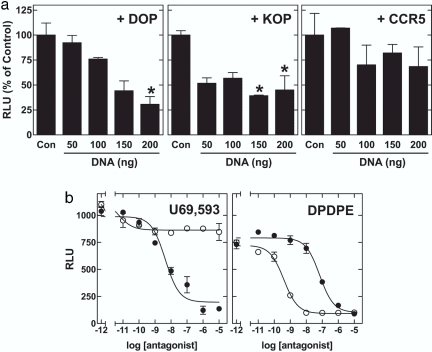Fig. 2.
Mechanism of 6′-GNTI agonism. (a)6′-GNTI agonist activity on heterodimers is not due to synergy/cooperativity between two opioid receptor types. HEK-293 cells expressing the KOP/DOP-R heterodimer were transiently transfected with the chimeric G protein Δ6-Gqi4-myr (200 ng for every 40,000 cells) and increasing amounts of DOP-R (Left), KOP-R (Center), or CCR5 (Right). Cells were stimulated with 100 nM 6′-GNTI, and intracellular Ca2+ release was measured as described for Fig. 1c. Maximum stimulation in the presence of 200 ng of control pcDNA3 (Con) was set at 100%. All data sets were subjected to a one-way ANOVA analysis with Bonferroni's multiple comparison posttest. *, A significant difference from the control with P < 0.05. (b) Effects of receptor type-selective antagonists on agonist-induced Ca2+ release in cells expressing the KOP/DOP-R heterodimer. Cells expressing the KOP/DOP-R heterodimer were preincubated for 30 min with increasing doses of NTI (○) or NorBNI (•) and stimulated with 1 nM U69,593 (Left) or 50 nM DPDPE (Right). Agonist-induced Ca2+ release was assessed as described for Fig. 1c. Shown are representative curves (mean ± SEM) of at least three experiments carried out in duplicate.

